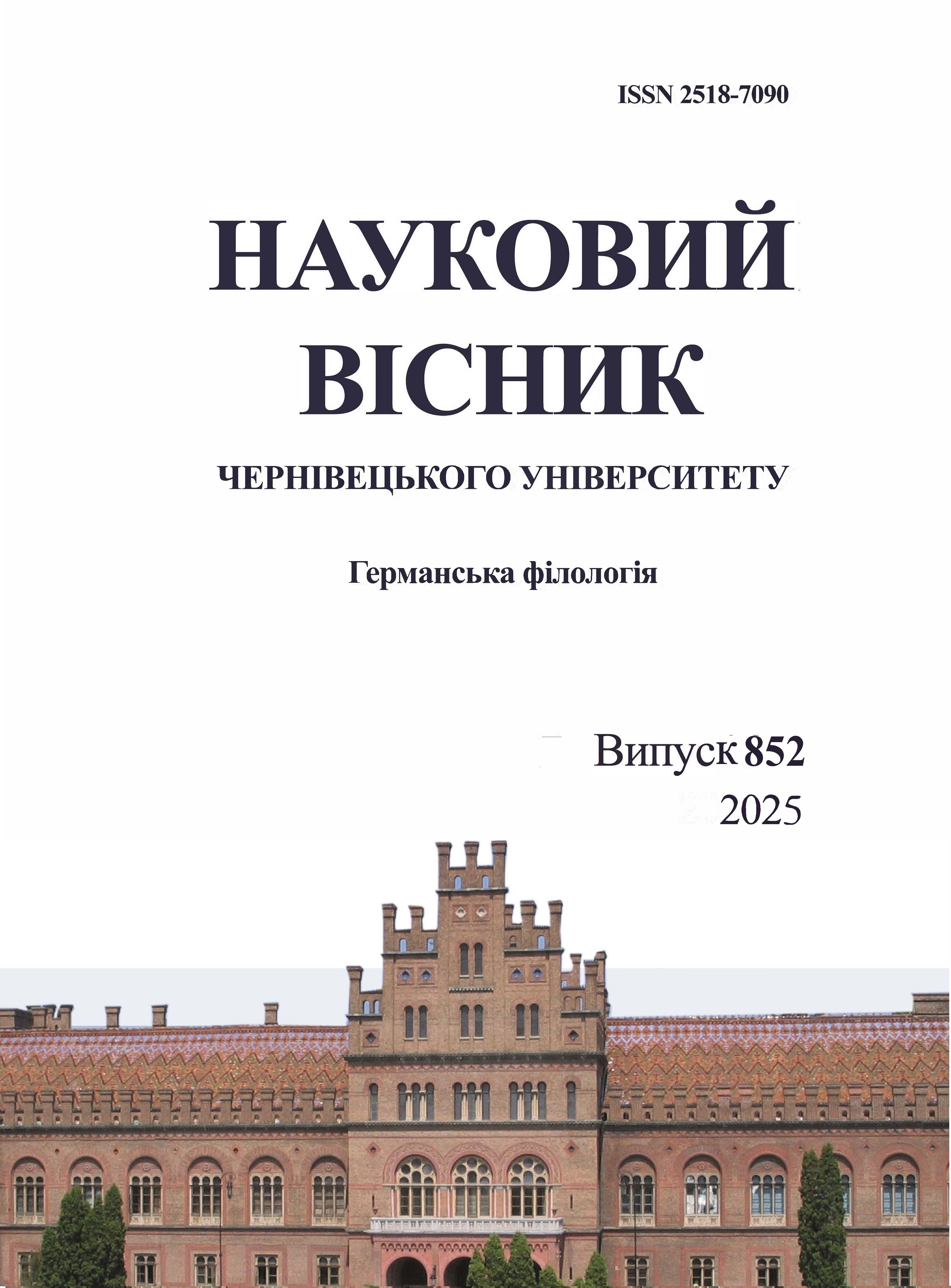SEMANTICS OF THE DWELLING OF THE ANCIENT GERMANS (BASED ON FAIRY TALES BY THE BROTHERS GRIMM)
DOI:
https://doi.org/10.31861/gph2025.852.124-132Keywords:
human dwelling, ancient Germans, semantics, emotions, types of dwellingAbstract
The article is devoted to outlining the semantics of the dwelling of the ancient Germans in the folklore literature of the fairy tale genre, the evolution of which is determined by extralinguistic and linguistic factors. The choice of the research topic is motivated by the anthropocentric approach to the consideration of problems of modern linguistics, the peripherality of the German language as an object of research and the fragmentation of special studies, respectively. The corpus of the analyzed phenomenon, which was compiled by the method of continuous selection from the first volume of the seventh edition of the collection of the Brothers Grimm "Kinder- und Hausmärchen" (1857), consists of 382 linguistic units. The definition of the concept of "housing" appeals to authentic reference literature on the historical axis (H. Paul, R. Schützeichel). It has been established that the dwelling of the ancient Germans varies: from natural (a tree hollow, forest, cave, grotto, etc.) to artificial (a house, hut, palace, tower, etc.). The semantics of dwelling in the folk tales collected and literary processed by the Brothers Grimm is diverse: positive, neutral, negative, indefinite. Reliable data on the above semantics were obtained through an integrated comprehensive methodology, which contains a number of methods and techniques, including general scientific (observation, analysis, synthesis, generalization), paradigmatic (descriptive, structural, functional) and special (contextual-interpretative, semantic and comparative analyses). As a result of the conducted scientific work, the ternary structure of the concept of “housing” of the ancient Germans was highlighted, its types, types, and functions were qualified, single and multiple housing of the so-called “economy, comfort, business, and premium class” were distinguished from the standpoint of psychology and religion, and the idea of the relationship between the type of housing and culture, the type of housing and the spiritual development of a person, the functions of housing and the emotions of an individual were confirmed.
Downloads
References
СПИСОК ЛІТЕРАТУРИ
Грушевська, К. (1926). Спроби соціологічного об’яснення народньої казки. К. Грушевська. Первісне громадянство та його пережитки на Україні. Київ: Державне видавництво України, 1–2, 96–111.
Копан, О.В., Мельник, В.І. (2016). Інформаційно-психологічна війна як засіб маніпулювання людською свідомістю. Інформація і право, 2 (17), 92–98.
Коцюба, В.К. (2016). Житло, двір, садиба (за матеріалами давньоруської лексики). Археологія і давня історія України, 3 (20), 113–136.
Культура побуту. Ізборник. Історія української культури. Т. 2. Узято з http://litopys.org.ua/istkult2/ikult206.htm
Просалова, Я.В. (2011). Семантична структура найменувань житлових будівель в англійській, німецькій, французькій, українській та російській мовах. Філологічні студії, 6, 2, 90–99.
Титаренко, В. (2022). Лексико-семантичні процеси в запозичених назвах приміщень та частин двору в північноукраїнському ареалі. Acta Academiae Beregsasiensis. Philologica, 2, 1, 25–40. DOI 10.58423/2786-6726/2022-2-25-40
Хомюк, Н.Л. (2018). Особливості формування категорії «сільські території». Науковий вісник Ужгородського національного університету. Серія: Міжнародні економічні відносини та світове господарство, 17, 2, 117–120.
Brüder Grimm (1857). Kinder- und Hausmärchen. Bd. 1. Göttingen: Dieterichschen Buchhandlung Verlag. URL: https://de.wikisource.org/wiki/Kinder-_und_Haus-M%C3%A4rchen_B and_1_(1857)
Paul, H. (1992). Deutsches Wörterbuch. Tübingen: Max Niemeyer Verlag.
Schützeichel, R. (1974). Althochdeutsches Wörterbuch. Tübingen: Max Niemeyer Verlag.
REFERENCES
Brüder Grimm (1857). Kinder- und Hausmärchen. Bd. 1. Göttingen: Dieterichschen Buchhandlung Verlag. URL: https://de.wikisource.org/wiki/Kinder-_und_Haus-M%C3%A4rchen _Band_1_(1857) [in German].
Hrushevska, K. (1926). Sproby sotsiolohichnoho obiasnennia narodnoi kazky [Attempts at a sociological explanation of a folk tale]. K. Hrushevska. Pervisne hromadianstvo ta ioho perezhytky na Ukraini – Primitive citizenship and its remnants in Ukraine. Kyiv: State Publishing House of Ukraine, 1–2, 96–111 [in Ukrainian].
Khomiuk, N.L. (2018). Osoblyvosti formuvannia katehorii “silski terytorii” [.Peculiarities of the formation of the category "rural territories"]. In Naukovyi visnyk Uzhhorodskoho natsionalnoho universytetu. Seriia: Mizhnarodni ekonomichni vidnosyny ta svitove hospodarstvo – Scientific Bulletin of Uzhhorod National University. Series: International Economic Relations and World Economy, 17, 2, 117–120 [in Ukrainian].
Kopan, O.V., Melnyk, V.I. (2016). Informatsiino-psykholohichna viina iak zasib manipuliuvannia liudskoiu svidomistiu [Information and psychological warfare as a means of manipulating human consciousness]. In Informatsiia I pravo – Information and law, 2 (17), 92–98 [in Ukrainian].
Kotsiuba, V.K. (2016). Zhytlo, dvir, sadyba (za materialamy davnoruskoi leksyky [Dwelling, yard, estate (based on materials from Old Russian vocabulary)]. In Arkheolohiia I davnia istoriia Ukrainy – Archaeology and ancient history of Ukraine, 3 (20), 113–136 [in Ukrainian].
Kultura pobutu. Izbornyk. Istoriia ukrainskoi kultury [Culture of everyday life. Collection. History of Ukrainian culture]. Tom 2 – Vol. 2. From http://litopys.org.ua/istkult2/ikult206.htm [in Ukrainian].
Paul, H. (1992). Deutsches Wörterbuch. Tübingen: Max Niemeyer Verlag [in German].
Prosalova, Ya.V. (2011). Semantychna struktura naimenuvan zhytlovykh budivel v anhliiskii, nimetskii, franzuskii, ukrainskii ta rosiiskii movakh [Semantic structure of names of residential buildings in English, German, French, Ukrainian and Russian]. In Filolohichni studii – Philological studies, 6, 2, 90–99 [in Ukrainian].
Schützeichel, R. (1974). Althochdeutsches Wörterbuch. Tübingen: Max Niemeyer Verlag [in German].
Tytarenko, V. (2022). Leksyko-semantychni protsesy v zapozychenykh nazvakh prymishchen ta chastyn dvoru v pivnichnoukrainskomy areali [Lexico-semantic processes in borrowed names of premises and parts of the yard in the North Ukrainian area]. In. Acta Academiae Beregsasiensis. Philologica, 2, 1, 25–40. DOI 10.58423/2786-6726/2022-2-25-40 [in Ukrainian].






